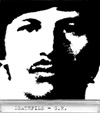 Among those in the know, Deathpile stands out as one of the finestpower electronics acts in the United States today. This incarnation ofthe project, consisting of founder Jonathan Canady and keyboardistDavid E. Williams, is as menacing and unsettling as ever, setting itssights on the true crime story of Gary Leon Ridgeway, ultimately knownas the Green River Killer. From the rumbling tones of the opener"Genesis," it becomes painfully clear that G.R.is a dark and gruesome journey into the sick heart of a serialmurderer. Not suitable for the weak of heart. the subsequent trackscrank up the intensity and the aggression one hundred fold.. Riding thecrushing waves of hot guttural noise on "Addicted" is the inhumanmonologue of Canady's roaring first-person narrative mixed withsnippets from an actual survivor interview. Taking this type of hideousreality-as-entertainment a step further, "Known Victims" painstakinglychronicles Ridgeway's fourty nine known victims over the course oftwelve and a half minutes, with an ironic and ominous female voicemonotonously reciting vital information as if off a checklist. However,the next track "All You'll Ever Get" claims that there may have been asmany as eighty more murdered women, keeping in with the type ofdepraved gloating Canady has already exhibited throughout thispersonification. Refusing to let up even after capture and arrest,"Kenworth" displays the murderer's defiance and sense ofaccomplishment, augmented by the track's nauseating mantra of "Who'slaughing now?" By the time the curious and vulgar unanswered questionsof "You Will Never Know"arrive, Deathpile's aural and psychologicalassault has left its mark, and the uncertainties reverberate endlesslyin the murky pool of phasing electronics. While the inclusion of alyric booklet may result in some snickering among the jaded types, theoverall quality of these tracks cannot be overlooked. Concise andto-the-point like all power electronics albums should be, G.R.represents a powerful and memorable moment in not only Deathpile'smusical career but also in record labels Force of Nature and Hospital.As the possibility of a final Deathpile performance looms (tentativelyscheduled to take place in March in New York City), this album may verywell be one of the final chapters in the history of this project, anending that is as uneasy to swallow as that of Gary Ridgeway.
Among those in the know, Deathpile stands out as one of the finestpower electronics acts in the United States today. This incarnation ofthe project, consisting of founder Jonathan Canady and keyboardistDavid E. Williams, is as menacing and unsettling as ever, setting itssights on the true crime story of Gary Leon Ridgeway, ultimately knownas the Green River Killer. From the rumbling tones of the opener"Genesis," it becomes painfully clear that G.R.is a dark and gruesome journey into the sick heart of a serialmurderer. Not suitable for the weak of heart. the subsequent trackscrank up the intensity and the aggression one hundred fold.. Riding thecrushing waves of hot guttural noise on "Addicted" is the inhumanmonologue of Canady's roaring first-person narrative mixed withsnippets from an actual survivor interview. Taking this type of hideousreality-as-entertainment a step further, "Known Victims" painstakinglychronicles Ridgeway's fourty nine known victims over the course oftwelve and a half minutes, with an ironic and ominous female voicemonotonously reciting vital information as if off a checklist. However,the next track "All You'll Ever Get" claims that there may have been asmany as eighty more murdered women, keeping in with the type ofdepraved gloating Canady has already exhibited throughout thispersonification. Refusing to let up even after capture and arrest,"Kenworth" displays the murderer's defiance and sense ofaccomplishment, augmented by the track's nauseating mantra of "Who'slaughing now?" By the time the curious and vulgar unanswered questionsof "You Will Never Know"arrive, Deathpile's aural and psychologicalassault has left its mark, and the uncertainties reverberate endlesslyin the murky pool of phasing electronics. While the inclusion of alyric booklet may result in some snickering among the jaded types, theoverall quality of these tracks cannot be overlooked. Concise andto-the-point like all power electronics albums should be, G.R.represents a powerful and memorable moment in not only Deathpile'smusical career but also in record labels Force of Nature and Hospital.As the possibility of a final Deathpile performance looms (tentativelyscheduled to take place in March in New York City), this album may verywell be one of the final chapters in the history of this project, anending that is as uneasy to swallow as that of Gary Ridgeway.samples:



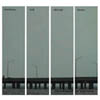 The next addition to in increasing collection of music by thesefantastically driven sonic players (see: Trapist, Radian, Dean Roberts)marries some of the free jazz tendencies with an affinity for retronoisemaking devices. Whereas the Trapist album reviewed last week wouldappeal to a number of Talk Talk fans, this album will probably find awarm place in the heart of many Wolf Eyes fans. While the liner notesdescribe the process of recording with respect to a room's atmosphereand space, my own mental image of the record is quite different. I seea very alien world. A world where the physical laws of nature that wehave grown accustomed to on this planet do not necessarily apply. Newcolors, new landscapes, and a new language, all of which are neitherdescribable nor translatable, but something which has to be experiencedfirst hand to truly appreciated. Recorded in 2001 and 2002, faintlytapped drum kits and timid guitars provide stability and recognitionwhile outbursts of analogue static and high frequency communicationlines blur the electromagnetism in the atmosphere. The planet and itscharacteristics are brilliantly established through "Part 1" and "Part2," while by "Part 3," actual beings are seemingly introduced. Like theutter bizzareness of the film Fantastic Planet,these foreign beings do not take recongnizable forms nor communicate inthe same way humans understand. It's on this track, "Part 3," whereit's almost as if a conversation is taking place between the aliens.Whether or not the quartet is imagining such a world during theirrecording is a different story, but the music created between themembers is very conversational, simply without words as we know them."Part 4" is much like a human contact would be to this new world. Thealien landscapes have been established but the guitar introducesitself, and at first, tries to mimic the electronic hums, drones andsqueals. As the contact between explorers and natives develops, eachtake turns in demonstrating what each species can do: the guitar andbass begin to play more familiar lines and between riffs, seems toalternate with the electronics for attention focus. This continues andescalates to the point of everybody playing together in a audio soup ofsorts, where everybody has let down their guard and has grown afondness for sharing themselves with new found friends. If Die InstabilitŠt der Symmetrieis like a visit to an alien world, the final track, "Part 5" is muchlike the sorrowful departure, as the melodies and tunes form in a veryconcluding manner, with low bass notes in a melancholy motion as thenew found friends must say goodbye, perhaps forever. The ship driftsoff into space as the whirry hums quell in the end. Fade to black. As aviewer to my own interpretation of the album as a fictitiousdocumentary, I hope the explorers and natives will meet up again someother day for another rewarding adventure.
The next addition to in increasing collection of music by thesefantastically driven sonic players (see: Trapist, Radian, Dean Roberts)marries some of the free jazz tendencies with an affinity for retronoisemaking devices. Whereas the Trapist album reviewed last week wouldappeal to a number of Talk Talk fans, this album will probably find awarm place in the heart of many Wolf Eyes fans. While the liner notesdescribe the process of recording with respect to a room's atmosphereand space, my own mental image of the record is quite different. I seea very alien world. A world where the physical laws of nature that wehave grown accustomed to on this planet do not necessarily apply. Newcolors, new landscapes, and a new language, all of which are neitherdescribable nor translatable, but something which has to be experiencedfirst hand to truly appreciated. Recorded in 2001 and 2002, faintlytapped drum kits and timid guitars provide stability and recognitionwhile outbursts of analogue static and high frequency communicationlines blur the electromagnetism in the atmosphere. The planet and itscharacteristics are brilliantly established through "Part 1" and "Part2," while by "Part 3," actual beings are seemingly introduced. Like theutter bizzareness of the film Fantastic Planet,these foreign beings do not take recongnizable forms nor communicate inthe same way humans understand. It's on this track, "Part 3," whereit's almost as if a conversation is taking place between the aliens.Whether or not the quartet is imagining such a world during theirrecording is a different story, but the music created between themembers is very conversational, simply without words as we know them."Part 4" is much like a human contact would be to this new world. Thealien landscapes have been established but the guitar introducesitself, and at first, tries to mimic the electronic hums, drones andsqueals. As the contact between explorers and natives develops, eachtake turns in demonstrating what each species can do: the guitar andbass begin to play more familiar lines and between riffs, seems toalternate with the electronics for attention focus. This continues andescalates to the point of everybody playing together in a audio soup ofsorts, where everybody has let down their guard and has grown afondness for sharing themselves with new found friends. If Die InstabilitŠt der Symmetrieis like a visit to an alien world, the final track, "Part 5" is muchlike the sorrowful departure, as the melodies and tunes form in a veryconcluding manner, with low bass notes in a melancholy motion as thenew found friends must say goodbye, perhaps forever. The ship driftsoff into space as the whirry hums quell in the end. Fade to black. As aviewer to my own interpretation of the album as a fictitiousdocumentary, I hope the explorers and natives will meet up again someother day for another rewarding adventure. Okay, already, I take it all back. The EP from this Brighton foursome released late last year didn't light me up, but this record is a delight from first track to last, and in between it has just enough touches of brilliance to guarantee a place in my CD player for weeks or months to come.
Okay, already, I take it all back. The EP from this Brighton foursome released late last year didn't light me up, but this record is a delight from first track to last, and in between it has just enough touches of brilliance to guarantee a place in my CD player for weeks or months to come.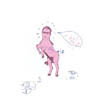 Andrew W.K. and Pink have never sounded better. Britney Spears andJustin Timberlake can be enjoyable! So long as the combination ofapples being gnawed up, pigs snorting, children laughing, andelephant-speak is processed, destroyed, and turned into a headfuck ofan album; then bad music can be made beautiful. Secret Mommy specializein the annihilation of all that sucks (including French educationalrecords) and all that can be used to make the pain of bad music lessexcruciating. The thirteen tracks on Mammal Classare composed of the dead bodies of pop stars, the flucuating anddecaying breath of large mammals, and various instruments that may ormay not be readily indentifiable; but who cares? This sort of thing hasbeen done for a while, now! What could possibly make me want to spendmoney on this record? First of all, "Bottom 40" features aspeak n' spell alongside Britney Spears and the mating calls of catsand turns out to be one hilarious and nerdy ride through funkdom.Second of all, the whole of this record is hilarious! "Shania Twang" isthe best combination possible of cowboy screams, mouth harp, ShaniaTwain samples, pigs, chickens, and off key banjo. "Andrew W. Cake" iscatchy, spontaneous, and makes the best use of Andrew W.K.'s outrageousmusic all while serving as a therapeutic means of getting back at allthose celebrities I've come to hate by using them in ways that wouldmake certain record companies jealous. Besides the funny aspect, a lotof the music here is just plain fun to listen to; it's the bestsynthesis of creativity and accessibility that I've found in a longwhile. What isn't cool about frogs, guitars, and girls being used tocreate rhythms that would send any dancing feet into the stratosphereand would also happen make certain "IDM" provocateurs red in the facefor their academic journey into blandness? Incessant giggling, goodtunes, and a real live imagination is the name of the game; this is themost entertaining time I've had listening to a record in forever. It'sextravagant, lushly melodic, and a real benchmark for other purveyorsof the strange and wonderous to test themselves by.
Andrew W.K. and Pink have never sounded better. Britney Spears andJustin Timberlake can be enjoyable! So long as the combination ofapples being gnawed up, pigs snorting, children laughing, andelephant-speak is processed, destroyed, and turned into a headfuck ofan album; then bad music can be made beautiful. Secret Mommy specializein the annihilation of all that sucks (including French educationalrecords) and all that can be used to make the pain of bad music lessexcruciating. The thirteen tracks on Mammal Classare composed of the dead bodies of pop stars, the flucuating anddecaying breath of large mammals, and various instruments that may ormay not be readily indentifiable; but who cares? This sort of thing hasbeen done for a while, now! What could possibly make me want to spendmoney on this record? First of all, "Bottom 40" features aspeak n' spell alongside Britney Spears and the mating calls of catsand turns out to be one hilarious and nerdy ride through funkdom.Second of all, the whole of this record is hilarious! "Shania Twang" isthe best combination possible of cowboy screams, mouth harp, ShaniaTwain samples, pigs, chickens, and off key banjo. "Andrew W. Cake" iscatchy, spontaneous, and makes the best use of Andrew W.K.'s outrageousmusic all while serving as a therapeutic means of getting back at allthose celebrities I've come to hate by using them in ways that wouldmake certain record companies jealous. Besides the funny aspect, a lotof the music here is just plain fun to listen to; it's the bestsynthesis of creativity and accessibility that I've found in a longwhile. What isn't cool about frogs, guitars, and girls being used tocreate rhythms that would send any dancing feet into the stratosphereand would also happen make certain "IDM" provocateurs red in the facefor their academic journey into blandness? Incessant giggling, goodtunes, and a real live imagination is the name of the game; this is themost entertaining time I've had listening to a record in forever. It'sextravagant, lushly melodic, and a real benchmark for other purveyorsof the strange and wonderous to test themselves by.  It is nearly impossible to discuss Camera Obscura without mentioningtheir fellow countrymen and kindred spirits Belle & Sebastian. Thecover photograph of the former's second album was taken by B&Sfrontman Stuart Murdoch (which alone screams of his own band's retro /twee stylings), in addition, he has produced one of Camera Obscura'searlier tracks. While CO might seem to owe a heavy debt to them, it isinteresting to note that both bands formed in 1996, and although theiroverall aesthetic is similar, the two clearly spring from differentminds. Underachievers Please Try Harderputs the band squarely in the realm of jangle-pop, and primary vocalistTraceyanne Campbell's gentle, breezy, inobtrusive vocals are perfectlycomplimentary. "Suspended from Class," "Teenager," and "Keep it Clean"are all classic examples of the genre with their sunny, simpleconstruction and topped off with twee lyrics. There are, however, a fewunexpected twists in this overall sound. "A Sister's Social Agony" hasechoes of the angelic, dreamy pop your parents might have danced to attheir prom, while "Your Picture" has a suprisingly melancholic tone.The latter may be the result of the Morrissey-esque male vocalist whotakes over for a few of the tracks. It is ultimately Camera Obscura'slyrics which seem to save them from lapsing into a saccharine overload.They are marked more by a pensive reflection on adolescence than bymere nostalgia. And although they aren't breaking any new ground withtheir music, they good a fine job of carrying the torch passed down tothem by their C86 forefathers.
It is nearly impossible to discuss Camera Obscura without mentioningtheir fellow countrymen and kindred spirits Belle & Sebastian. Thecover photograph of the former's second album was taken by B&Sfrontman Stuart Murdoch (which alone screams of his own band's retro /twee stylings), in addition, he has produced one of Camera Obscura'searlier tracks. While CO might seem to owe a heavy debt to them, it isinteresting to note that both bands formed in 1996, and although theiroverall aesthetic is similar, the two clearly spring from differentminds. Underachievers Please Try Harderputs the band squarely in the realm of jangle-pop, and primary vocalistTraceyanne Campbell's gentle, breezy, inobtrusive vocals are perfectlycomplimentary. "Suspended from Class," "Teenager," and "Keep it Clean"are all classic examples of the genre with their sunny, simpleconstruction and topped off with twee lyrics. There are, however, a fewunexpected twists in this overall sound. "A Sister's Social Agony" hasechoes of the angelic, dreamy pop your parents might have danced to attheir prom, while "Your Picture" has a suprisingly melancholic tone.The latter may be the result of the Morrissey-esque male vocalist whotakes over for a few of the tracks. It is ultimately Camera Obscura'slyrics which seem to save them from lapsing into a saccharine overload.They are marked more by a pensive reflection on adolescence than bymere nostalgia. And although they aren't breaking any new ground withtheir music, they good a fine job of carrying the torch passed down tothem by their C86 forefathers.  Ielasi will be best known for his label, Fringes, which has beenbrightening the Italian improv community for the past six years with aslew of successful releases. Starting out as a guitarist, he performedin several bristly, tense ensembles (even playing acoustic at times)before easing into electronic improvisation, a transition thatintroduced a more understated method of expression and produced worksthat, while full of the scrape and bounce that characterize Ielasi'sguitar-playing, contain new attention towards careful sculpting of thesmooth approach and weightless hover of each piece. Such concerns haveexploded with Plans;at only thirty minutes, the piece is a major addition to Ielasi'salready-intimidating catalog and marks a considerable stylistic shiftfor the artist. Not a work of pure improvisation, Plans wasactually created over a sixteen-month interval and is of remarkablydense construction, including everything from layered field recordings,thick accumulations of vinyl surface noise, and a toy museum's worth ofclatter and acoustic tinker, to the surprisingly "present"accompaniment of live drums and Ielasi's narcotic strumming. Not onlydoes Plans travel through a succession of movements, but themusic transitions with rare, effortless stride, captivating in itsjoining of contrastive sounds and playing styles, over passages thatnot only sound perfectly-aligned but maintain an emotional current thatremains close to the surface. This is the power of Plans; itsimmediately palpable, almost nostalgic beauty becomes a catalyst forforgetting just how intact Ielasi leaves his sound sources. Plaintivechordal phrasing lines up neatly next to the most atonal, asymmetricalbits of sturm und drang, all sounds recognizably different, even (itwould seem) in direction, but down to the slightest of details each onefits and seems created with full knowledge of every foreign item thatwill graze its path. Like the artist's recent improvisations, Planslifts dense assemblage to airy heights without the sacrifice of thesounds' material qualities. One particularly illuminating moment comesin the third or fourth "movement" when out of breezy, layered surfacenoise Ielasi introduces a pristine recording of keys fumbling and heavymetal doors being swung open and shut. These harsh, solid soundsimmediately take their place within the airborne whisper of the whole,an explicit representation of Plans' achievement, iron doorsswinging between the clouds. It is not hard to believe that thisrelatively short piece took so long to create. Even the improvisedelements appear intricately placed, often spliced via electronics tofit the multiplicity of layers and the "larger," more demandingcompositional structure. This music demands repeated listening, and itsrewards, I've found, are almost limitless, such that I cannot evenmuster predictable criticism of the disc's short length. Plansis an easy favorite from the new crop of Sedimental releases and leavesme hoping Ielasi's next work will continue in similar stride.
Ielasi will be best known for his label, Fringes, which has beenbrightening the Italian improv community for the past six years with aslew of successful releases. Starting out as a guitarist, he performedin several bristly, tense ensembles (even playing acoustic at times)before easing into electronic improvisation, a transition thatintroduced a more understated method of expression and produced worksthat, while full of the scrape and bounce that characterize Ielasi'sguitar-playing, contain new attention towards careful sculpting of thesmooth approach and weightless hover of each piece. Such concerns haveexploded with Plans;at only thirty minutes, the piece is a major addition to Ielasi'salready-intimidating catalog and marks a considerable stylistic shiftfor the artist. Not a work of pure improvisation, Plans wasactually created over a sixteen-month interval and is of remarkablydense construction, including everything from layered field recordings,thick accumulations of vinyl surface noise, and a toy museum's worth ofclatter and acoustic tinker, to the surprisingly "present"accompaniment of live drums and Ielasi's narcotic strumming. Not onlydoes Plans travel through a succession of movements, but themusic transitions with rare, effortless stride, captivating in itsjoining of contrastive sounds and playing styles, over passages thatnot only sound perfectly-aligned but maintain an emotional current thatremains close to the surface. This is the power of Plans; itsimmediately palpable, almost nostalgic beauty becomes a catalyst forforgetting just how intact Ielasi leaves his sound sources. Plaintivechordal phrasing lines up neatly next to the most atonal, asymmetricalbits of sturm und drang, all sounds recognizably different, even (itwould seem) in direction, but down to the slightest of details each onefits and seems created with full knowledge of every foreign item thatwill graze its path. Like the artist's recent improvisations, Planslifts dense assemblage to airy heights without the sacrifice of thesounds' material qualities. One particularly illuminating moment comesin the third or fourth "movement" when out of breezy, layered surfacenoise Ielasi introduces a pristine recording of keys fumbling and heavymetal doors being swung open and shut. These harsh, solid soundsimmediately take their place within the airborne whisper of the whole,an explicit representation of Plans' achievement, iron doorsswinging between the clouds. It is not hard to believe that thisrelatively short piece took so long to create. Even the improvisedelements appear intricately placed, often spliced via electronics tofit the multiplicity of layers and the "larger," more demandingcompositional structure. This music demands repeated listening, and itsrewards, I've found, are almost limitless, such that I cannot evenmuster predictable criticism of the disc's short length. Plansis an easy favorite from the new crop of Sedimental releases and leavesme hoping Ielasi's next work will continue in similar stride.  Though odder and odder this one becomes with each listen, I think I'vefinally found the piece of my heart that loves The Elected. With onefoot planted firmly in the indie psyche-rock weeds and the other in themore low-down country aspects of life, this Los Angeles ensemble playswith genres and styles in an effort to find their niche, but the truthis they needn't try so hard sometimes. Me Firstis a well-paced and structured debut with funny, intelligent lyricsabout classic themes but with clever twists. All the while, there'splenty to swallow whole, as savoring it instead of devouring it won'tmake it any more logical or understood, like the finer moments of theFlaming Lips or the Shins. This is the road trip record for drivingthrough the dusty south and southwest, with pure Americana and shortstories to keep the feet firmly on the ground, though the mind is freeto roam. Blake Sennett, principal songwriter and guitarist in RiloKiley, is also the mastermind behind The Elected, and certainsimilarities can be found in the two bands. Sennett seems to have someya-yas to get out about relationships, though, and that's where thesesongs have their strengths. Whether it's failed romantic relationshipsor hiding the secrets from family and friends, the subjects of thesongs are lived-in, and that's the the real appeal of The Elected'sdebut. In the age of vapid and vacant pop stars who steal the beats andbasslines of classic songs to try and duplicate the stardom or revive agenre bigger than them, it's nice to hear a band that can just do theirthing and sound like they've been around forever making music with thebands of the age. This is record I will be listening to all year, I canjust feel it.
Though odder and odder this one becomes with each listen, I think I'vefinally found the piece of my heart that loves The Elected. With onefoot planted firmly in the indie psyche-rock weeds and the other in themore low-down country aspects of life, this Los Angeles ensemble playswith genres and styles in an effort to find their niche, but the truthis they needn't try so hard sometimes. Me Firstis a well-paced and structured debut with funny, intelligent lyricsabout classic themes but with clever twists. All the while, there'splenty to swallow whole, as savoring it instead of devouring it won'tmake it any more logical or understood, like the finer moments of theFlaming Lips or the Shins. This is the road trip record for drivingthrough the dusty south and southwest, with pure Americana and shortstories to keep the feet firmly on the ground, though the mind is freeto roam. Blake Sennett, principal songwriter and guitarist in RiloKiley, is also the mastermind behind The Elected, and certainsimilarities can be found in the two bands. Sennett seems to have someya-yas to get out about relationships, though, and that's where thesesongs have their strengths. Whether it's failed romantic relationshipsor hiding the secrets from family and friends, the subjects of thesongs are lived-in, and that's the the real appeal of The Elected'sdebut. In the age of vapid and vacant pop stars who steal the beats andbasslines of classic songs to try and duplicate the stardom or revive agenre bigger than them, it's nice to hear a band that can just do theirthing and sound like they've been around forever making music with thebands of the age. This is record I will be listening to all year, I canjust feel it.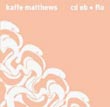 CD Eb + Flo marks a number of departures in the work of one of today's most interesting sound artists. The double-disc is Matthews' first solo release using theremin as primary sound source, following her retiring of the violin which had formed the core of her excellent first three discs (recently reissued as a trio). The artist's method remains somewhat constant on Eb + Flo, involving the live sampling and laptop manipulation of sounds created with the theremin and projected via quadraphonic soundsystem throughout a particular room.
CD Eb + Flo marks a number of departures in the work of one of today's most interesting sound artists. The double-disc is Matthews' first solo release using theremin as primary sound source, following her retiring of the violin which had formed the core of her excellent first three discs (recently reissued as a trio). The artist's method remains somewhat constant on Eb + Flo, involving the live sampling and laptop manipulation of sounds created with the theremin and projected via quadraphonic soundsystem throughout a particular room. Aranos is a unique musician, a classically-trained cellist andmulti-instrumentalist whose resume is not filled with the usual chambermusic ensembles, modern composition or minimalist drone work that onemight expect. Instead, he has become noteworthy based on a series ofuncategorizable collaborations with Nurse With Wound that sidestep allof the usual implications of avant-classical composition. Aranos'peculiar style is based in the Eastern European gypsy songs, trad-folkand rock music of his childhood in Czechoslovakia. From hiscollaborations with Steven Stapleton, he absorbed the techniques ofdislocated psychedelia and surrealistic composition. Those techniqueswere in full display with the Irish jigs, skewed gypsy fiddles andcracked experimentation of his first two albums for his own Pieroslabel. For this album, Aranos collaborates with El Monte, the nom deguerre of Nick Mott of Volcano The Bear. Allied Cooking But Not As You Know It!is a collection of eleven improvised tracks, utilizing an array ofinstruments including the usual strings, shakahuchi, trumpet,saxophone, gongs and an array of homemade instruments. In a techniqueworthy of Eno's Oblique Strategies, each improvisation is based uponmeditation on a nonsensical imperative — "Think Like Warm IntestinalBeing!" or "Think Like Madly Projected Fleshcups!" Their collaborationresults in a series of low key tracks, meandering around a series ofsubtle conversations that scrupulously avoid musicality entirely.Several tracks create the abstract mental imagery of dark jungles anddamp marshes, with the slowly rubbed cello strings creating an creepingatmosphere of dread. At other times, the music is decidedly morehyperactive, Aranos jumping over his strings like a frog in a fryingpan. On "Think Like Veering Toads and Rude Proons!" an odd speakerglitch creates a brief piece of minimalist electronica worthy of theRaster-Noton label. Apparently, this was all recorded and mixed in thespan of a week that El Monte spent in Ireland with Aranos.Unfortunately, this really shows, as the whole affair seems to sufferfrom a severe dearth of well-executed musical ideas, attempting tocompensate for this lack with an overdose of creepy atmospherics,exclamation points and surreal gobbledygook.
Aranos is a unique musician, a classically-trained cellist andmulti-instrumentalist whose resume is not filled with the usual chambermusic ensembles, modern composition or minimalist drone work that onemight expect. Instead, he has become noteworthy based on a series ofuncategorizable collaborations with Nurse With Wound that sidestep allof the usual implications of avant-classical composition. Aranos'peculiar style is based in the Eastern European gypsy songs, trad-folkand rock music of his childhood in Czechoslovakia. From hiscollaborations with Steven Stapleton, he absorbed the techniques ofdislocated psychedelia and surrealistic composition. Those techniqueswere in full display with the Irish jigs, skewed gypsy fiddles andcracked experimentation of his first two albums for his own Pieroslabel. For this album, Aranos collaborates with El Monte, the nom deguerre of Nick Mott of Volcano The Bear. Allied Cooking But Not As You Know It!is a collection of eleven improvised tracks, utilizing an array ofinstruments including the usual strings, shakahuchi, trumpet,saxophone, gongs and an array of homemade instruments. In a techniqueworthy of Eno's Oblique Strategies, each improvisation is based uponmeditation on a nonsensical imperative — "Think Like Warm IntestinalBeing!" or "Think Like Madly Projected Fleshcups!" Their collaborationresults in a series of low key tracks, meandering around a series ofsubtle conversations that scrupulously avoid musicality entirely.Several tracks create the abstract mental imagery of dark jungles anddamp marshes, with the slowly rubbed cello strings creating an creepingatmosphere of dread. At other times, the music is decidedly morehyperactive, Aranos jumping over his strings like a frog in a fryingpan. On "Think Like Veering Toads and Rude Proons!" an odd speakerglitch creates a brief piece of minimalist electronica worthy of theRaster-Noton label. Apparently, this was all recorded and mixed in thespan of a week that El Monte spent in Ireland with Aranos.Unfortunately, this really shows, as the whole affair seems to sufferfrom a severe dearth of well-executed musical ideas, attempting tocompensate for this lack with an overdose of creepy atmospherics,exclamation points and surreal gobbledygook. 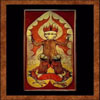 Dave Wright's approach to music serves as his greatest strength and thehinge upon which his weakness rests. Near every song on his newestrelease has a soundtrack quality to it, coming across as if it belongedto any number of gritty sci-fi movies from the past twenty years. Thereare layers upon layers of jumbled drum tracks, erratic signal chaos,computer malfunctions, and muscular bass melodies. I can see the floorsof abandoned houses soaked and creaking from numerous leaks, the lightof candles flickering across the walls, and the awkward crawl ofshadows jumping across the room with the sudden gusts of air billowingthrough the rooms; but what's missing is some element that keeps mewanting to come back. Carrion Soundsfeels so thematic that I find that I have difficulty maintaininginterest throughout the album. By the time "Worlock Radar" drops itsblack breath over my head, I'm feeling rather removed from the musicand there's little making me want to get back into it. Some of thesongs just over-extend their welcome: seven minutes of insane drumprogramming and strobe-light special effects is difficult to sitthrough unless it's done to perfection. With that in mind, "BebeBarron's Panties" (featuring Mr. Meat Beat Manifesto) is a realstandout: it isn't one of the longest tracks on the disc, but the spacethat Jack Dangers provides in between the sounds improves the formulathat Not Breathing works with throughout the duration of the album. Carrion Soundsis unique, however, many of the sounds have a life all their own anddon't feel overused or familiar. David Wright certainly providesinteresting rhythmic and melodic combinations, but overall fails tokeep my attention for a long stretch of time. I find the record pullingat me every now then for a quick and heavy dose, but the record is besttaken in steps: Wright certainly has a lot of talent, just a littlerefinement and this record would be excellent.
Dave Wright's approach to music serves as his greatest strength and thehinge upon which his weakness rests. Near every song on his newestrelease has a soundtrack quality to it, coming across as if it belongedto any number of gritty sci-fi movies from the past twenty years. Thereare layers upon layers of jumbled drum tracks, erratic signal chaos,computer malfunctions, and muscular bass melodies. I can see the floorsof abandoned houses soaked and creaking from numerous leaks, the lightof candles flickering across the walls, and the awkward crawl ofshadows jumping across the room with the sudden gusts of air billowingthrough the rooms; but what's missing is some element that keeps mewanting to come back. Carrion Soundsfeels so thematic that I find that I have difficulty maintaininginterest throughout the album. By the time "Worlock Radar" drops itsblack breath over my head, I'm feeling rather removed from the musicand there's little making me want to get back into it. Some of thesongs just over-extend their welcome: seven minutes of insane drumprogramming and strobe-light special effects is difficult to sitthrough unless it's done to perfection. With that in mind, "BebeBarron's Panties" (featuring Mr. Meat Beat Manifesto) is a realstandout: it isn't one of the longest tracks on the disc, but the spacethat Jack Dangers provides in between the sounds improves the formulathat Not Breathing works with throughout the duration of the album. Carrion Soundsis unique, however, many of the sounds have a life all their own anddon't feel overused or familiar. David Wright certainly providesinteresting rhythmic and melodic combinations, but overall fails tokeep my attention for a long stretch of time. I find the record pullingat me every now then for a quick and heavy dose, but the record is besttaken in steps: Wright certainly has a lot of talent, just a littlerefinement and this record would be excellent. 